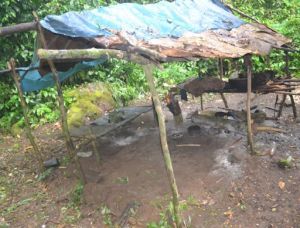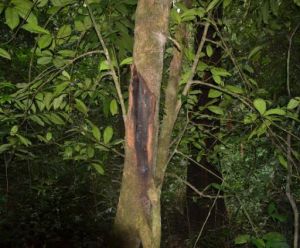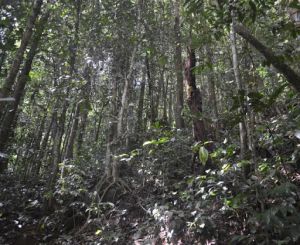Ebo Forest
Central Africa > Cameroon > Ebo Forest
Summary
- Nigeria-Cameroon chimpanzees (Pan troglodytes ellioti) and gorillas (Gorilla gorilla) are present in Ebo Forest.
- The population sizes are unknown.
- The population trends are unknown.
- The site has a total size of 1417 km².
- Key threats to great apes are illegal logging, poaching, and building of a road which will increase pressure on wildlife.
- Conservation activities have focused on community-led conservation initiatives, such as promoting alternative sustainable livelihoods, conservation education and community-based gorilla monitoring.
- Ebo forest is home to a population of geographically intermediate gorillas (the population is found between Cross River Gorillas and Western Lowland Gorillas) that is potentially a third subspecies of western gorillas.
Site characteristics
Located in southwestern Cameroon, the biodiversity and cultural significance of the Ebo forest is remarkable. Ebo is the most important tract of intact forest in the Gulf of Guinea Biodiversity Hotspot and an important carbon sink (approx. 35 million tonnes of carbon). Ebo forest is a haven for animal and plant species that characterise this biodiversity hotspot and that have been extirpated in other parts of the region, including a population of geographically intermediate gorillas that is potentially a third subspecies of gorillas in Cameroon. The forest is also home to one of the most important remaining populations of Nigeria-Cameroon chimpanzees (Pan troglodytes ellioti). Culturally, the forest has been home to the Ndokbiakat clan of the Banen tribe for all of recorded history. The forest is full of archaeological history, including colonial roads, stone-built missionary buildings, and ancient village sites that were abandoned around the time of Cameroon's Independence in 1960. The burial sites of close relatives of patriarchs and matriarchs are situated in these village sites along with other cultural relics of the Banen tribe (Abwe & Morgan 2020).
Table 1. Basic site information for Ebo Forest
| Area | 1417 km² |
| Coordinates | 4.315484, 10.329629 |
| Designation | Non-protected area |
| Habitat types | Subtropical/tropical moist lowland forest, subtropical/tropical montane forest |
IUCN habitat categories Site designations
Ape status
In 2002, a new population of gorillas was found in the Ebo forest (previously only nests were seen). The Ebo gorillas are an isolated, relict population - their nearest neighbouring gorilla populations to the north are the Cross River gorillas, and the nearest surviving southern populations are western lowland gorillas, over 100 km south of the Sanaga river. As such, the Ebo gorillas really are of particular interest as they likely represent what might once have been a much more continuous distribution of gorillas over this region (Morgan 2010). The site holds one of the most important remaining populations of Nigeria-Cameroon chimpanzees (Abwe & Morgan 2020).
Table 2. Ape population estimates in Ebo Forest
| Species | Year | Abundance estimate (95% CI) | Density estimate [ind./ km²] (95% CI) | Encounter rate (nests/km) | Area | Method | Source | Comments | A.P.E.S. database ID |
|---|---|---|---|---|---|---|---|---|---|
| Pan troglodytes ellioti' & Gorilla gorilla | 2008-2009 | Present | Ebo Forest | Index survey (reconnaissance walk) | Whytock et al. 2021 | survey effort: 345 km | |||
| Gorilla gorilla | 2019-2020 | Present | North of Ebo Forest, 39 sq.km | Camera trap survey | Whytock et al. 2021 |
Threats
The main threats to wildlife in Ebo forest include habitat loss, poaching and the bushmeat trade (Abwe & Morgan 2020). In 2020, the Government of Cameroon proposed two Forest Management Units (FMU) for timber exploitation which completely cover the proposed Ebo National Park in Littoral Region, Cameroon. Widespread and systematic timber exploitation across the site would exacerbate habitat loss and poaching (Abwe & Morgan 2020). When civil society groups opposed the destruction of the species-rich forest, the government suspended the logging concessions (Atabong 2022). In 2022, bulldozers opened around 40 km of dirt road running north from the village of Kopongo, across a forestry concession and into the heart of Ebo Forest. A group calling itself the Ebo Forest Development Committee is behind the project, stating that the road is needed to connect villages around Ebo, give access to communities that were displaced from the forest in the 1950s, and stimulate the local economy. However, a local news outlet, Journal du Cameroun, reported that the road is actually being built by a logging company (Atabong 2022). As of April 2023, part of the forest (68,385 ha) has been reclassified for logging (Nkemnyi, S., pers. comm. 2023).
Table 3. Threats to apes in Ebo Forest
| Category | Specific threats | Threat level | Quantified severity | Description | Year of threat |
|---|---|---|---|---|---|
| 1. Residential & commercial development | Unknown | ||||
| 2. Agriculture & aquaculture | 2.1 Annual & perennial non-timber crops | Low | Palm plantations and conversion of forest into farmland (Nkemnyi, S., pers. comm. 2023). | Ongoing (2023) | |
| 3. Energy production & mining | Unknown | ||||
| 4. Transportation & service corridors | 4.1 Roads & railroads | High | Bulldozers have opened around 40 km of dirt road into Ebo Forest (Atabong 2022). | Ongoing (2022) | |
| 5. Biological resource use | 5.1 Hunting & collecting terrestrial animals | High | Poaching for the bushmeat trade (Abwe & Morgan 2020, Whytock et al. 2021). | Ongoing (2021) | |
| 5.2 Gathering terrestrial plants | Low | Extraction of non-timber forest products for local use and income generation (Nkemnyi, S., pers. comm. 2023). | Ongoing (2023) | ||
| 5.3 Logging & wood harvesting | High | Global Forest Watch data show accelerated forest loss in the logging concession south of Ebo, known as FMU 07 002, with more than 1,100 hectares of forest cover lost in 2021 (Atabong 2022). In 2023, part of the forest was reclassified for large-scale logging. Illegal selective logging also takes place (Nkemnyi, S., pers. comm. 2023). | Ongoing (2023) | ||
| 6. Human intrusion & disturbance | Unknown | ||||
| 7. Natural system modifications | Unknown | ||||
| 8. Invasive & other problematic species, genes, diseases | Unknown | ||||
| 9. Pollution | Unknown | ||||
| 10. Geological Events | Absent | ||||
| 11. Climate change & severe weather | Unknown | ||||
| 12. Other options | Absent |
Conservation activities
Community conservation outreach around the Ebo forest targets traditional authorities who play an important role in maintaining the cultural, political, social and economic integrity of their communities. Each community member has a stake in the management of resources around them, and their involvement in biodiversity conservation can lead to positive behaviours toward threatened species in particular and biodiversity in general. Since 2012, the "Club des Amis des Gorilles" initiative aims to encourage local communities around the gorilla habitat to be directly involved in monitoring for gorilla signs and threats in the forest around their villages, as well as raising awareness about the significance of gorillas and other species within and outside their communities (Abwe et al. 2015).
Table 4. Conservation activities in Ebo Forest
| Category | Specific activity | Description | Year of activity |
|---|---|---|---|
| 1. Residential & commercial development | Not reported | ||
| 2. Agriculture & aquaculture | Not reported | ||
| 3. Energy production & mining | Not reported | ||
| 4. Transportation & service corridors | Not reported | ||
| 5. Biological resource use | 5.17. Provide sustainable alternative livelihoods; establish fish- or domestic meat farms | A poultry project was initiated in the Mosse community in 2014 with more than 300 fowls produced. However, the demand was low within the small community and marketing the fowls was a challenge given the long distances to neighbouring populations and the poor state of roads (Abwe et al. 2015). | Unknown |
| 6. Human intrusion & disturbance | Not reported | ||
| 7. Natural system modifications | Not reported | ||
| 8. Invasive & other problematic species, genes, diseases | Not reported | ||
| 9. Pollution | Not reported | ||
| 10. Education & Awareness | 10.1. Educate local communities about primates and sustainable use | promote positive behaviours towards gorillas, chimpanzees and other wildlife through sensitisation and conservation education within and outside communities (Abwe et al. 2015). | Ongoing (2015) |
| 10.2. Involve local community in primate research and conservation management | The "Club des Amis des Gorilles" monitor gorillas and threats towards them within their habitat in order to record the human impact on this fragile population (Abwe et al. 2015). | Ongoing (2015) | |
| 10.3. Install billboards to raise primate conservation awareness | Billboards (Abwe et al. 2015). | Ongoing (2015) | |
| 10.5. Implement multimedia campaigns using theatre, film, print media, discussions | Conservation education messages in storytelling, songs, on T-shirts, posters, parades, presentations, banners and billboards are widely used. Storytelling sessions where elders tell heroic animal stories to youths and school children are organised regularly in Iboti and Locndeng (Abwe et al. 2015). | Ongoing (2015) | |
| 11. Habitat Protection | Not reported | ||
| 12. Species Management | Not reported | ||
| 13. Livelihood; Economic & Other Incentives | 13.3. Run research project and ensure permanent human presence at site | Three stations established as part of San Diego Zoo's Ebo Forest Research Project (Morgan 2010). | Ongoing (2010) |
| 13. Livelihood; Economic & Other Incentives | 13.2. Provide non-monetary benefits to local communities for sustainably managing their forest and its wildlife (e.g. better education, infrastructure development) | With the support of EFRP, high yielding cocoa bean nursery projects have been carried out in Iboti, Locndeng and Locnanga. The seedlings from the nurseries have been transplanted into CAG and other community members’ individual farms (Abwe et al. 2015). | Ongoing (2015) |
Conservation activities list (Junker et al. 2017)
Challenges
Table 5. Challenges reported for Ebo Forest
| Challenge | Source |
|---|---|
| Lack of political will | Nkemnyi, S., pers. comm. 2023 |
Research activities
The San Diego Zoo's Ebo Forest Research Project established three permanently-manned research stations in the Ebo forest. The first station, established 2005, concentrates on the ecology and behaviour of the drill and chimpanzees, although botany research has been ongoing since 2005. The second research station was established in early 2008 to specifically concentrate on conserving and studying the small gorilla population, which occurs in a relatively small (c. 25 km²) area in this region of the forest. Finally, the Njuma research station was established in early 2009 to concentrate research on chimpanzees and Preuss's red colobus monkey (Morgan 2010). The forest has been a site of interest for researchers and students from several government institutions, such as the National Herbarium, which has led botanical inventories in the area since 2005; the universities of Buea, Douala, Dschang, Yaounde and the National Forestry School, Mbalmayo; as well as several researchers and students from universities across the world (Abwe & Morgan 2020).
Documented behaviours
Table 6. Ape behaviors reported for Ebo Forest
| Behavior | Source |
|---|---|
| Not reported |
External links
Re:wild- Ebo Forest: A Stronghold for Cameroon’s Wildlife
References
Abwe, E.E., B.J. Morgan. (2020). Gorillas of the Ebo forest threatened by proposed Forest management Units for timber exploitation. Gorilla Journal 60. 18-20.
Abwe, E. E., Mfossa, D. M., & Morgan, B. J. (2015). Community-led conservation action in the Ebo forest, Cameroon.
Atabong, A. B. (2022). Private road sparks fears for Cameroon’s Ebo Forest. Retrieved 23 May 2023 from Mongabay. Online: https://news.mongabay.com/2022/08/private-road-sparks-fears-for-cameroons-ebo-forest/
Morgan, B.J. (2010). The gorillas of the Ebo forest, Cameroon. Gorilla Journal 40. 16-18.
Whytock, R.C., E.E. Abwe, D.M. Mfossa, M.E. Ketchen, A.E. Abwe, V.R.V. Ngimdo, F. Maisels, S. Strindberg, B.J. Morgan. (2021). Mammal distribution and trends in the threatened Ebo 'intact forest landscape', Cameroon. Global Ecology and Conservation 31.
Page completed by: Nkemnyi Standly & A.P.E.S. Wiki team Date: 19/07/2023


